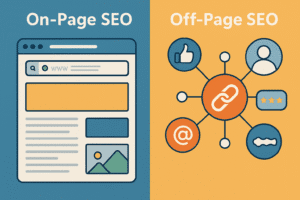In today’s digital age, where consumers are constantly glued to their screens, social media has emerged as a powerful tool for retailers to connect with their audience, foster meaningful relationships, and drive sales. Gone are the days when traditional advertising alone could guarantee success. Now, a well-crafted strategy for social media marketing for retail, coupled with your website, can elevate your brand, engage your customers, and ultimately, boost your bottom line. In this comprehensive guide, we’ll delve into the strategies and tactics that can help you harness the full potential of social media marketing for retail.
Why Social Media Marketing for Retail is a Game-Changer
Social media is more than just a platform for sharing photos and updates; it’s a dynamic marketplace where brands can build communities, showcase products, and interact with customers in real-time. Here are ways you can do social media marketing for retail:
- Building Brand Awareness: By establishing a strong presence on relevant platforms, you can introduce your brand to a wider audience and increase recognition.
- Driving Website Traffic: Share engaging content and irresistible offers on social media to entice followers to visit your online store.
- Generating Leads and Sales: Leverage social commerce features to enable seamless shopping experiences directly within social platforms.
- Providing Customer Service: Respond to inquiries and address concerns promptly on social media, demonstrating your commitment to customer satisfaction.
- Gaining Valuable Insights: Analyze social media data to understand your audience’s preferences, behaviors, and pain points, and tailor your marketing strategies accordingly.
Choosing the Right Platforms: Navigating the Landscape of Social Media Marketing for Retail
With a multitude of social media platforms vying for attention, selecting the right ones for your retail business can be overwhelming. To make an informed decision, consider your target audience, their preferred platforms, and the nature of your products or services.
Some of the best platforms for social media marketing for retail include:
- Facebook: With its vast user base and robust advertising capabilities, Facebook offers a wide reach and diverse audience for retailers.
- Instagram: A visually-driven platform perfect for showcasing products, sharing lifestyle content, and engaging with younger demographics.
- Pinterest: A visual search engine where users discover and save inspiration for their purchases, making it ideal for products with strong visual appeal.
- TikTok: A rapidly growing platform for short-form video content, offering opportunities for creative and engaging brand storytelling.
- Twitter: A real-time platform for conversations and updates, suitable for customer service and staying on top of industry trends.
Selecting the ideal social media platforms for your business can be a complex decision, but it’s a crucial step towards maximizing your reach and engagement. If you’re unsure which platforms are best suited for your target audience and brand, KatMantra can provide tailored recommendations and help you craft a winning social media strategy. Book a FREE consultation to explore how we can elevate your brand’s social media presence.
Content Creation: Crafting Compelling Stories That Sell
A successful social media marketing campaign hinges on captivating content that resonates with your target audience. Think of it as the digital equivalent of a window display – it should entice passersby to step inside and explore what your brand has to offer.
The Art of Storytelling in Social Media Marketing for Retail
In the realm of social media, storytelling is king. People don’t just want to see product photos; they want to be drawn into a narrative that connects with their emotions and aspirations. Share stories about your brand’s journey, the inspiration behind your products, or the positive impact your products have on your customers’ lives.
Visual content reigns supreme on platforms like Instagram and Pinterest. High-quality photos and videos that showcase your products in action, lifestyle imagery that reflects your brand’s values, and behind-the-scenes glimpses into your company culture can all contribute to a vibrant and engaging social media presence.
How to Use Social Media Marketing for Retail: Content Creation Tips
To make the most of your social media content creation efforts, consider these tips:
- Know Your Audience: Tailor your content to the interests and preferences of your target audience. What kind of content do they engage with most? What are their pain points and aspirations?
- Develop a Content Calendar: Plan your content in advance to ensure consistency and maintain a steady stream of posts. This will help you stay organized and avoid last-minute scrambling.
- Variety is Key: Mix up your content formats to keep your audience engaged. Share a combination of product photos, lifestyle images, videos, behind-the-scenes glimpses, customer testimonials, and even the occasional meme or funny post.
- Embrace User-Generated Content: Encourage your customers to share their experiences with your products on social media. This can create a sense of community and authenticity around your brand.
- Leverage Trending Topics: Keep an eye on trending hashtags and topics relevant to your industry and incorporate them into your content when appropriate.
- Write Compelling Captions: Craft captions that capture attention, spark curiosity, and encourage interaction. Use relevant hashtags to increase your content’s visibility.
By following these tips, you can create a content strategy that not only showcases your products but also tells a compelling story that resonates with your audience and drives them to action. Remember, in the world of social media marketing for retail, content is the currency that fuels engagement, builds relationships, and ultimately, drives sales.
Advertising : Social Media Marketing for Retail to Reaching New Heights
While organic reach on social media is valuable, it often has limitations. To expand your brand’s visibility and reach a wider audience, social media advertising for retail offers a powerful solution. By investing in targeted ads, you can put your products in front of the right people at the right time, driving traffic to your website and boosting conversions.
Understanding Social Media Advertising Platforms
Each social media platform has its own advertising options and targeting capabilities. Here’s a quick overview of some popular platforms:
- Facebook Ads: Facebook’s vast user base and sophisticated targeting options make it a popular choice for retail advertising. You can target users based on demographics, interests, behaviors, and even lookalike audiences (users similar to your existing customers).
- Instagram Ads: With its visually appealing format and focus on lifestyle content, Instagram is ideal for showcasing products and reaching younger demographics. You can run ads in the feed, Stories, or Explore tab.
- Pinterest Ads: Pinterest’s Promoted Pins allow you to reach users who are actively searching for inspiration and ideas related to your products. You can target ads based on keywords, interests, and demographics.
- TikTok Ads: TikTok’s in-feed ads and branded hashtag challenges offer unique opportunities to reach a younger, trend-conscious audience with engaging video content.
Crafting Effective Social Media Ads
To create social media ads that capture attention and drive results, consider the following tips:
- Compelling Visuals: Use high-quality images or videos that showcase your products in an appealing way. Optimizing your website goes a long way.
- Strong Headline: Write a concise and attention-grabbing headline that clearly communicates your message.
- Persuasive Ad Copy: Highlight the benefits of your products and include a clear call to action (e.g., “Shop Now,” “Learn More”).
- Targeted Audience: Carefully define your target audience based on demographics, interests, and behaviors to ensure your ads reach the right people.
- A/B Testing: Experiment with different ad formats, visuals, and targeting options to identify what works best for your brand.
- Budget Management: Set a budget for your social media advertising campaigns and monitor your spending to ensure you’re getting a good return on investment (ROI).
Social Media Advertising Tips for Small Businesses
- Start Small: Don’t feel pressured to invest a large budget in social media advertising. Start with a small campaign and gradually increase your spending as you see results.
- Focus on Your Goals: Clearly define your advertising objectives (e.g., increase brand awareness, drive website traffic, generate leads) and tailor your campaigns accordingly.
- Monitor and Optimize: Track your ad performance regularly and make adjustments as needed to improve your results.
By leveraging the power of social media advertising for retail, you can expand your reach, target specific demographics, and achieve your marketing goals more effectively.
Influencer Marketing: Amplifying Your Brand’s Reach
In the age of social media, influencers have emerged as powerful voices that can sway consumer opinions and drive purchasing decisions. Influencer marketing involves partnering with individuals who have a significant following and influence within your target market to promote your products or services. This can be an effective way to reach a wider audience, build credibility, and generate buzz around your brand.
Identifying the Right Influencers
Not all influencers are created equal. When selecting influencers to partner with, consider the following factors:
- Relevance: Choose influencers whose audience aligns with your target market. Their followers should be interested in the types of products or services you offer.
- Engagement: Look for influencers with high engagement rates (likes, comments, shares) on their posts. This indicates that their audience is actively involved and receptive to their content.
- Authenticity: Partner with influencers who genuinely believe in your brand and products. Authenticity is key to building trust with their audience.
- Reach: Consider the influencer’s reach (number of followers) and the potential exposure your brand will receive through their channels.
Types of Influencer Collaborations
There are various ways to collaborate with influencers:
- Sponsored Posts: Pay influencers to create and share content featuring your products or services.
- Product Reviews: Send influencers your products for them to review and share their honest opinions with their audience.
- Giveaways and Contests: Partner with influencers to host giveaways or contests that promote your brand and generate excitement.
- Brand Ambassadors: Establish long-term partnerships with influencers who consistently represent your brand and values.
Measuring the Impact of Influencer Marketing
Track the performance of your influencer marketing campaigns to assess their effectiveness. Monitor metrics like website traffic, social media engagement, and sales generated through influencer partnerships. This data can help you identify which influencers and strategies are delivering the best results.
Building Relationships with Influencers
Cultivating strong relationships with influencers is essential for successful long-term partnerships. Treat influencers with respect, communicate clearly, and provide them with the resources they need to create compelling content that resonates with their audience.
By strategically incorporating influencer marketing into your social media marketing strategy for retail, you can tap into new audiences, build brand credibility, and drive meaningful engagement with your target market.
Community Building: Cultivating Relationships and Fostering Loyalty for Social Media Marketing for Retail
Social media is more than just a broadcasting platform; it’s a two-way street where conversations and connections flourish. Community building is an essential aspect of social media marketing for retail, enabling you to foster relationships with your customers, create a sense of belonging, and cultivate brand loyalty.
Engaging with Your Audience
Don’t just post content and disappear. Actively engage with your followers by responding to comments, answering questions, and participating in conversations. This shows that you value their input and are committed to building relationships.
Encouraging User-Generated Content
User-generated content (UGC) is a powerful tool for building community and social proof. Encourage your customers to share their experiences with your products or services on social media, and repost their content on your own channels. This not only showcases real-life testimonials but also makes your customers feel valued and appreciated.
Hosting Contests and Giveaways
Contests and giveaways can be a fun and effective way to generate excitement, increase engagement, and attract new followers. Offer enticing prizes that are relevant to your target audience, and encourage participants to share your content or tag their friends.
Social Media Tips for Small Businesses: Community Building
- Create a Branded Hashtag: Encourage customers to use a specific hashtag when sharing content related to your brand. This makes it easier to track and engage with UGC.
- Host Live Q&A Sessions: Use live video features on platforms like Instagram or Facebook to answer customer questions in real-time and foster a sense of connection.
- Create a Facebook Group or Community: Build a dedicated space for your most loyal customers to connect, share ideas, and provide feedback.
- Run Social Media Polls and Surveys: Gather valuable insights from your audience and show them that you value their opinions.
By actively fostering a sense of community on social media, you can turn casual followers into loyal brand advocates who are more likely to make repeat purchases and recommend your products to others.
Providing Excellent Customer Service on Social Media
Social media is increasingly becoming a primary channel for customer service inquiries. Monitor your social media channels for comments, messages, and mentions of your brand. Respond promptly and professionally to any questions or concerns, demonstrating your commitment to customer satisfaction.
Remember, a negative experience shared on social media can quickly go viral and damage your brand reputation. By proactively addressing issues and providing exceptional customer service, you can turn a potentially negative situation into a positive one and showcase your brand’s dedication to its customers.
Social Media Analytics: Measuring Success and Optimizing Strategies for Social Media Marketing for Retail
In the realm of social media marketing, data is your compass. By tracking key metrics and analyzing your performance, you can gain valuable insights into what’s working, what’s not, and how to optimize your strategies for maximum impact.
Key Social Media Metrics to Track
Several essential metrics can help you gauge the effectiveness of your social media marketing for retail:
- Reach: The number of people who have seen your content.
- Engagement: The number of likes, comments, shares, and other interactions your content receives.
- Impressions: The number of times your content has been displayed, even if it wasn’t clicked on.
- Clicks: The number of times users have clicked on a link in your social media posts.
- Conversions: The number of sales or leads generated directly from your social media efforts.
- Follower Growth: The rate at which your follower count is increasing or decreasing.
Unveiling Deeper Insights: The Power of Social Media Analytics Tools
While the built-in analytics dashboards on social media platforms offer a glimpse into your performance, they often lack the depth and granularity required for strategic decision-making. To truly understand the impact of your social media efforts and refine your social media marketing strategy for retail, consider leveraging the capabilities of dedicated social media analytics tools. These tools provide a wealth of data and actionable insights that can help you fine-tune your strategies, maximize engagement, and drive tangible results.
Google Analytics: Your E-commerce Traffic Maestro
Google Analytics remains an indispensable tool for tracking website traffic from various sources, including social media. By integrating your social media accounts with Google Analytics, you can gain a comprehensive understanding of how your social media efforts are contributing to website visits, conversions, and overall business goals. This allows you to see which social platforms are driving the most valuable traffic, helping you allocate your resources effectively.
How to Improve SEO for Ecommerce Websites: Leverage Social Media Data
Analyzing social media data can also provide valuable insights for your SEO strategy. By understanding which types of content resonate most with your audience, you can create more targeted and effective SEO content that drives organic traffic to your website. For more info, here is a detailed guide on SEO for your website.
Optimizing Your Social Media Marketing for Retail Strategy
Use the insights gleaned from your social media analytics to refine your strategies and improve your results for social media marketing for retail:
- Identify Top-Performing Content: Analyze which posts and content formats generate the most engagement and reach. Replicate these successes and experiment with similar approaches.
- Experiment with Different Posting Times: Test different posting times to determine when your audience is most active and likely to engage with your content.
- Refine Your Targeting: Analyze demographic data and audience insights to ensure your ads and content are reaching the right people.
- Track Your ROI: Measure the return on investment for your social media marketing efforts by tracking conversions and sales generated through social channels.
By consistently monitoring your social media analytics and making data-driven decisions, you can optimize your strategies, improve your results, and achieve greater success with your social media marketing for retail.
Conclusion: WordPress: Your Social Media Marketing for Retail Hub
In today’s digitally connected world, social media marketing for retail is an essential component of any successful retail strategy. By establishing a strong presence on the right platforms, creating engaging content, leveraging advertising and influencer marketing, building a community, and tracking your performance, you can harness the power of social media to connect with your audience, drive sales, and achieve your business goals.
Remember, social media marketing is an ongoing process. It requires consistent effort, adaptation to evolving trends, and a willingness to experiment and learn. By staying engaged with your audience, providing valuable content, and fostering meaningful relationships, you can build a loyal following that supports your brand and contributes to your long-term success.
For businesses using WordPress, integrating social media into your e-commerce strategy is seamless. WordPress offers a wide array of plugins and tools that facilitate social sharing, content integration, and even social commerce functionality. With the right setup, you can streamline your social media marketing efforts and manage everything from a single platform.
By embracing social media and making it an integral part of your retail marketing strategy, you can unlock new opportunities for growth, connect with your customers on a deeper level, and build a thriving online community around your brand.
For businesses using WordPress, integrating social media into your e-commerce strategy is a breeze. WordPress offers a wide array of plugins and tools that facilitate social sharing, content integration, and even social commerce functionality. If you’re looking to build a WordPress website that seamlessly integrates with social media and empowers you to effectively engage with your audience, KatMantra can help. We specialize in creating user-friendly, visually appealing, and SEO-optimized WordPress websites that are tailored to your unique business needs. Book a FREE consultation today to learn more about our web design services and how we can help you achieve your social media marketing goals.
FAQ
How to promote a retail store on social media?
Promoting your retail store on social media involves a multifaceted approach:
- Choosing the Right Platforms: Identify the platforms where your target audience is most active. Popular choices for retail include Facebook, Instagram, Pinterest, TikTok, and Twitter.
- Crafting Engaging Content: Create high-quality visuals, compelling captions, and shareable stories that resonate with your audience.
- Leveraging Social Media Advertising: Run targeted ads to reach a wider audience and achieve specific marketing objectives.
- Collaborating with Influencers: Partner with influencers in your niche to promote your products or services to their followers.
- Building a Community: Actively engage with your followers, respond to comments, and foster a sense of belonging around your brand.
What is social media marketing in retail?
Social media marketing in retail involves using social media platforms to connect with customers, build brand awareness, and drive sales. It encompasses a range of activities, including content creation, advertising, influencer marketing, and community building.
What is the best social media platform for retail?
The best social media platform for retail depends on your specific target audience and business goals. However, some popular options include Facebook, Instagram, Pinterest, and TikTok. Each platform offers unique advantages and targeting capabilities.
Why social media is important for retail businesses?
Social media is crucial for retail businesses because it allows them to:
- Reach a wider audience: Expand your brand’s visibility beyond your physical store or website.
- Build brand awareness and loyalty: Create a strong online presence and foster relationships with your customers.
- Drive traffic and sales: Attract potential customers to your store or website and encourage them to make purchases.
- Provide customer service: Address customer inquiries and concerns promptly and efficiently.
- Gain valuable insights: Gather data on your audience’s preferences and behaviors to inform your marketing strategies.
How social media increases sales?
Social media increases sales by:
- Generating leads: Attracting potential customers to your products or services.
- Building trust and credibility: Showcasing positive customer experiences and reviews.
- Facilitating direct purchases: Enabling social commerce through shoppable posts and integrated checkout options.
- Offering exclusive promotions: Running targeted ads and offering special discounts to social media followers.
- Creating a sense of urgency: Utilizing limited-time offers and flash sales to encourage immediate purchases.
How does social media attract customers?
Social media attracts customers through:
- Eye-catching visuals: Sharing high-quality images and videos that showcase your products in an appealing way.
- Compelling storytelling: Crafting narratives that resonate with your audience’s emotions and aspirations.
- Engaging content: Posting informative, entertaining, or inspiring content that encourages interaction and shares.
- Targeted advertising: Reaching the right people with relevant ads based on demographics, interests, and behaviors.
- Influencer partnerships: Leveraging the reach and influence of popular individuals to promote your brand.
What are the advantages of social media in retail?
The advantages of social media in retail include:
- Increased brand awareness and reach
- Improved customer engagement and loyalty
- Cost-effective marketing and advertising
- Direct sales opportunities through social commerce
- Valuable customer insights and feedback
Does social media help the profitability of a small store?
Yes, social media can significantly contribute to the profitability of a small store by increasing brand visibility, driving traffic, and generating sales. It offers a cost-effective way to reach a targeted audience and compete with larger retailers.
How to market retail on social media?
Marketing retail on social media involves:
- Choosing the right platforms: Identify where your target audience is most active.
- Creating engaging content: Share visually appealing and informative content that resonates with your audience.
- Running targeted ads: Reach specific demographics and interests with tailored ad campaigns.
- Collaborating with influencers: Partner with influencers who align with your brand values to promote your products.
- Building a community: Engage with your followers, respond to comments, and foster a sense of belonging.
- Tracking and analyzing your performance: Use social media analytics to measure your results and optimize your strategies.
What is the role of social media in retail marketing?
Social media plays a vital role in retail marketing by enabling businesses to connect with their audience, build brand awareness, drive traffic and sales, provide customer service, and gain valuable insights.
How social media is changing the retail business?
Social media is transforming the retail business in several ways:
- Shifting power to consumers: Customers have more influence than ever before, shaping brand perception through reviews and social sharing.
- Enabling direct-to-consumer sales: Social commerce allows businesses to sell directly to customers on social platforms.
- Fostering real-time engagement: Brands can interact with customers in real-time, building relationships and addressing concerns.
- Democratizing marketing: Small businesses can compete with larger brands on social media through engaging content and targeted advertising.

I design high-performing WordPress + Elementor websites and WooCommerce stores that rank on Google and convert visitors into customers. At Katmantra Web Design and SEO, I combine clean design with smart SEO so your site works as hard as you do.





